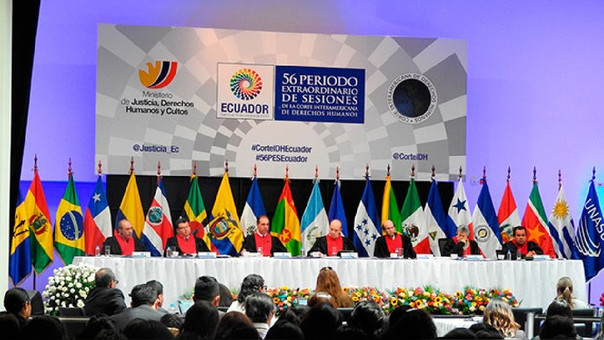 The decision made by Brazil, Colombia, Chile, Paraguay, and Peru to leave the Union of South American Nations (UNASUR) represents a practical coup de grace for the institution created in Brasilia in 2008. It also illustrates the political shift that has taken place in the majority of countries that created the Union, and the impossibility of agreements between the rightwing governments and the governments of Venezuela and Bolivia, since all decisions must be made by consensus.
The decision made by Brazil, Colombia, Chile, Paraguay, and Peru to leave the Union of South American Nations (UNASUR) represents a practical coup de grace for the institution created in Brasilia in 2008. It also illustrates the political shift that has taken place in the majority of countries that created the Union, and the impossibility of agreements between the rightwing governments and the governments of Venezuela and Bolivia, since all decisions must be made by consensus.
The UNASUR crisis began with the electoral changes in its member countries and deepened since January of 2017, when Colombian ex-president Ernesto Samper ended his term as the organization’s Secretary General. At that point, the pro tempore Presidency was passed to Argentina, which proposed its ambassador to Chile, Octavio Bordón, as a replacement. Bordón had been a member of the center-left FREPASO (Frente País Solidario) confederation of Argentine political parties in the mid 1990’s and Argentina’s ambassador to the United States under the Kirchner administration. Bolivia rejected the proposal and the Union has been without a leader for the last sixteen months.
Although the backdrop is political, the organization’s paralysis resulted in the memo sent last week to the ambassador of Bolivia (which currently oversees the pro tempore Presidency) by the six aforementioned countries, stating their intent to withdraw from UNASUR until its functions are redefined. They describe the situation as “extremely intolerable”, which is why they also suspended their payments and their participation in all the organization’s operations.
Venezuelan President Maduro has asked the exiting nations to show “a little bit of South American conscience” and has speculated that the decision may be due to “pressure” from the United States. Except for Bolivia, the rest of the UNASUR countries have criticized the quality of Venezuela’s democracy and many of them, such as those belonging to the so-called Lima Group, have urged the government to take measures that they believe will help restore democracy in that country. In January, representatives from Argentina, Brazil, Colombia, Mexico, Panama and Peru were invited to a meeting in Washington to discuss the Venezuela situation with Juan Cruz, the United States National Security Council’s Director for Western Hemisphere Affairs. The same leaders were invited by Donald Trump to discuss the issue at a meeting during the United Nation’s General Assembly last September. At that meeting, the Latin American heads of state – with the exception of Peru’s Pedro Pablo Kuczynski and Mexico’s Enrique Peña Nieto, who each cancelled their travel plans to New York due to domestic problems – expressed to Trump their rejection of a possible military intervention in Venezuela.
The six countries that have withdrawn from UNASUR are members of the Lima Group, formed Aug. 8, 2017 in the Peruvian capital by twelve American nations: Argentina, Brazil, Canada, Chile, Colombia, Costa Rica, Guatemala, Honduras, Mexico, Panama, Paraguay, and Peru. This bloc of countries has met and issued several ambassador-level statements in an attempt to find ways out of the Venezuelan crisis. The group has stated that there cannot be free and fair elections when there are political leaders under arrest or arbitrarily disqualified, the country’s political parties cannot fully participate, the electoral authority is Government-controlled, millions of Venezuelans around the world are unable to vote and the elections are organized by the constituent assembly whose existence and decisions they do not recognize as an organ deemed to be lacking legitimacy and legality. They called on the Venezuelan government to allow the opening of a humanitarian corridor to help mitigate the serious effects of food and medicine shortages.
The Lima Group’s strategy has been to isolate Venezuela politically and diplomatically without imposing sanctions. This is the context in which the Group’s member countries decided to abandon UNASUR, whose remaining members are now the smaller countries: Suriname, Guyana, Bolivia, Uruguay, Ecuador (location of the Union’s headquarters), and Venezuela.
UNASUR’s history
The Union of South American nations was the name given to the then-South American Community of Nations in April 2007 by presidents of the region who had gathered for the first time ever to discuss energy issues. They didn’t simply decide to give the organization a new name, but a new focus. This would not be the merger of the two existing regional blocs, the Andean Community and MERCOSUR, but a new space for political negotiations, in which social, energy, and infrastructure issues would be the central areas of attention, leaving commercial issues on the back burner.
The change in focus and the abandonment of commercial issues in UNASUR were due to the fact that negotiations for the free trade zone between the Andean Community and MERCOSUR took longer than expected and a number of South American countries – including Chile, Colombia, and Peru – began negotiations to open trade with countries outside the region in other free trade agreements. Also, the Andean Community did not jointly sign an Economic Complementation Agreement with MERCOSUR. Bolivia signed in 1996, which made it a MERCOSUR Associated State. Peru signed with MERCOSUR in 2005, and in the same year Colombia, Ecuador, and Venezuela jointly signed with MERCOSUR. These events were decisive in the move to leave commercial issues out of UNASUR. It was no coincidence that representatives from the Andean Community and MERCOSUR were not invited to the signing ceremony of UNASUR’s Constituent Treaty.
This new focus was expressed in the text of the Constituent Treaty, signed in Brasilia in May 2008. The Union was born with a strong political profile, centered on regional security. UNASUR played a central, influential role in the region’s political conflicts shortly after its creation in 2008. It participated in the Bolivian conflicts between the central government and the autonomous regional governments that led to the deaths of 30 people in September 2008, the consultations over the installation of U.S. military bases in Colombia in 2009, and the attempted removal of Ecuador’s President Correa at the end of September 2010.
UNASUR established clear objectives: build a participatory, consensus-based space for cultural, social, economic, and political integration and union among its people, prioritizing political dialogue, social policies, education, energy, infrastructure, financing and the environment. It sought to eliminate socioeconomic inequality, achieve social inclusion and civic participation, and bolster democracy while reducing asymmetries in strengthening member states’ sovereignty and independence.
These objectives, without a doubt, were laudable. However there were numerous obstacles in solidifying the agreement. The weight of ideological alliances and domestic geopolitical projects above regional interests, political differences between South American leaders – including within sectors that would be favorable to the formation of a regional autonomous bloc – on types of development, integration models and options for international participation, that put ideologies ahead of the interest in community, are some of them.
In spite of these differences, during the first years of its existence UNASUR took actions that had international repercussions and gave it a political presence as a bloc, stealing the thunder of both the Organization of American States in regional conflict resolution and the Interamerican Development Bank in infrastructure integration.
UNASUR’s creation did not take place in a conflict-free context. The resignation of the former President of Ecuador, Rodrigo Borja, from his position as executive secretary; the latent effects of the crisis between Ecuador, Colombia, and Venezuela rooted in the FARC’s military incursion into Ecuadorian territory in March 2008; and Colombia’s refusal to assume the pro tempore presidency were some of the events that served as a backdrop for the ratification of UNASUR’s Constituent Treaty by the South American heads of state in May 2008.
When then-president of Colombia Álvaro Uribe rejected the pro tempore presidency, due to Colombia’s conflict with Venezuela and Ecuador over military incursion in Ecuadorian territory, it was taken on by then-president of Chile, Michelle Bachelet. Bachelet signaled the need to emphasize consensus and a priority on getting the Union up and moving, to give South America the opportunity to have a strong, clear voice on the world stage. One day before the first UNASUR summit, she declared that South American countries “cannot give themselves the luxury of missing this tremendous opportunity”.
However, her good wishes have been eclipsed today by changes in the region’s political path. The larger countries have “temporarily” abandoned UNASUR, and initial support for the organization’s functionality and institutionalism, which regional leaders had once been swift to invoke to make clear that UNASUR, not the OAS, would resolve South American political issues – has been lost.
 Ariela Ruiz Caro is an economist from the Humboldt University of Berlin with a master’s degree in Economic Integration processes from the University of Buenos Aires. International consultant on issues of trade, integration and natural resources in ECLAC, Latin American Economic System (SELA), Institute for the Integration of Latin America and the Caribbean (INTAL), among others. She has been an official of the Andean Community between 1985 and 1994 and advisor to the Commission of Permanent Representatives of MERCOSUR between 2006 and 2008. She is a columnist for the Americas Program.
Ariela Ruiz Caro is an economist from the Humboldt University of Berlin with a master’s degree in Economic Integration processes from the University of Buenos Aires. International consultant on issues of trade, integration and natural resources in ECLAC, Latin American Economic System (SELA), Institute for the Integration of Latin America and the Caribbean (INTAL), among others. She has been an official of the Andean Community between 1985 and 1994 and advisor to the Commission of Permanent Representatives of MERCOSUR between 2006 and 2008. She is a columnist for the Americas Program.
Translation for the Americas Program: Lindsey Hoemann



